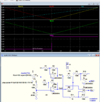I am building a controller for a brushed DC motor. Would like to use a typical game console joystick to effect fwd/rev switching as well as the speed signal for each direction.
I am able to use photo-interrupters on the stick to signal fwd & rev.
However using the 10K pot on the joystick as a speed ref input to my PWM motor controller is a bit trickier...
Assuming the stick's spring-center position is off, the pot wiper reads 5k (center pot)
Moving stick upward the wiper goes from 5K to 10K . Thats a useable increasing voltage from pot to increase the motor speed.
Moving stick downward the wiper goes from 5K to 0K , that would be a decreasing speed signal to the motor cntrllr.
Ideally I would like to find a way to make the pots' voltage signal go zero to max in each direction from the stick center
I was reading an old 2008 post from EricGibbs where he was describing use of the inverting input on a single-supply opamp which would reverse the voltage signal of 5-0V to 0-5V. But the schematic is no longer visible in that old post.
Appreciate any ideas, thanks
Bob
I am able to use photo-interrupters on the stick to signal fwd & rev.
However using the 10K pot on the joystick as a speed ref input to my PWM motor controller is a bit trickier...
Assuming the stick's spring-center position is off, the pot wiper reads 5k (center pot)
Moving stick upward the wiper goes from 5K to 10K . Thats a useable increasing voltage from pot to increase the motor speed.
Moving stick downward the wiper goes from 5K to 0K , that would be a decreasing speed signal to the motor cntrllr.
Ideally I would like to find a way to make the pots' voltage signal go zero to max in each direction from the stick center
I was reading an old 2008 post from EricGibbs where he was describing use of the inverting input on a single-supply opamp which would reverse the voltage signal of 5-0V to 0-5V. But the schematic is no longer visible in that old post.
Appreciate any ideas, thanks
Bob


